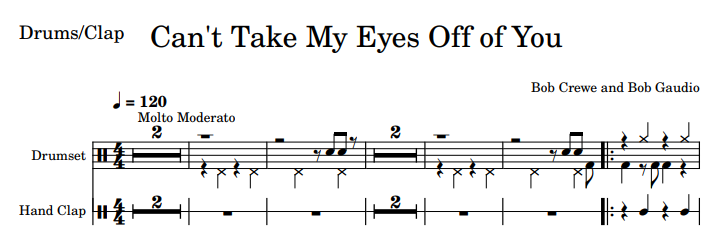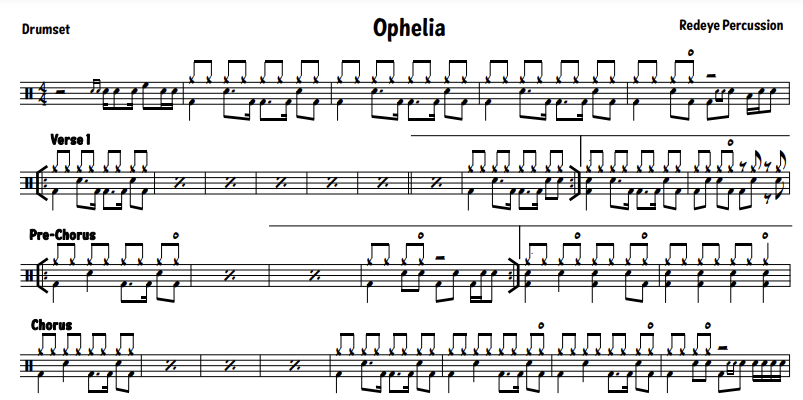Drums
new in 5.3
We owe many thanks to Brian Boe for his decisive contribution to this long-awaited functionality.
First requests for drums notation go back to 2017, see Audiveris issue #33. This delay certainly originated in my personal ignorance (Hervé speaking) about this kind of notation.
Table of contents
Example
This Wikipedia article provides a good introduction to drums notation.
Since 5.3 release, Audiveris supports drums unpitched notation on both 5-line and 1-line staves, as shown in the following excerpt:

- Each staff starts with a percussion clef,
- Each individual instrument is defined by a given head motif at a given line position
(drum set mapping). - Though not specific to drums notation, we can frequently observe multi-measure rests and measure-repeat signs.
Processing switches
To be able to transcribe the example above, we have to set two specific processing book parameters, available in dialog Book | Set Book Parameters, one for 1-line and one for 5-line percussion stave sizes:

In batch mode, we can also set these switches at command line interface level:
-option org.audiveris.omr.sheet.ProcessingSwitches.oneLineStaves=true
-option org.audiveris.omr.sheet.ProcessingSwitches.drumNotation=true
Drum set mapping
There seems to be no universal specification for drum set mapping, only some recommandations.
This means that, depending on a score author, the mapping can be different.
Audiveris provides a default mapping via the drum-set.xml file in its res resource folder.
Content of this XML file is listed in appendix.
Within the drum-set XML root element, there is one staff XML element per staff size (one for 1-line staves, one for 5-line staves).
The mapping definition is a list of entries within the containing staff XML element.
- It is presented by increasing line/space number, but only for ease of browsing.
- Each
entryXML element contains the following XML attributes:- ”
pitch-position”: line/space number (0 being the mid-line, values increasing top down) - ”
motif”: general head shape (oval, small, cross, diamond, triangle, circle) - ”
sound”: intrument name (Acoustic_Bass_Drum, etc. see appendix) - ”
sign”: this attribute is optional, it indicates a playing technique (PLAYING_OPEN, PLAYING_HALF_OPEN, PLAYING_CLOSED)
- ”
This protected resource is just the default mapping:
- As an end-user, we can always incrementally override some or all of the default mapping entries, by writing our own entries in a similar but certainly smaller
drum-set.xmlfile to be located in userconfigfolder. - To “nullify” an existing default entry, we simply specify a “
null” value for its “sound” attribute.
Transcription
Among the examples used when working on drums with Brian, we can recommand the Redeye Percussion site.
Its “Sheet Music” top link gives access to hundreds of percussion scores.
Here below is the example of Ophelia, a simple one-page score.
Beginning of the PDF file, downloaded from Redeye Percussion site, is as follows:

Before launching the OMR engine, we specify book parameters using the Book | Set Book Parameters dialog:

Note the specific selections made:
- Music font: We do need the “JazzPerc” music font family for best efficiency on this example.
- 5-line unpitched percussion staves: this will allow the processing of drums notation on 5-line staves
- Small heads: we have cue heads in this score
- Small beams: we have cue beams tied to the cue heads
And with no additional user action, the raw transcription gives:

There is one abnormal measure, shown in pink.
It is due to a flag mistaken with a black head, something easy to fix.
Should we need to manually fix other transcription errors, we would certainly end up playing with the HeadsAndDot palette in the shape board.
For the “Jazz Perc” font family and the selected processing switches, this palette provides the following symbols:

It is organized as follows:
- First, the heads part:
- One row per head motif (
ovalthroughcircle) - One column per head increasing duration (1/4, 1/2 , 1, 2)
- One row per head motif (
- The next row is dedicated to the augmentation dot and the pre-built quarter and half notes.
- The last row presents the playing signs 1 (open, half-open, closed) that can appear away from heads.
Appendix
Here below is the content of drum-set.xml file provided in Audiveris res application folder.
Remember the end user can still override some default definitions via a similar drum-set.xml file to be located in user config folder.
<?xml version="1.0" encoding="UTF-8" standalone="yes"?>
<!-- =========================================================================================== -->
<!-- -->
<!-- d r u m - s e t . x m l -->
<!-- -->
<!-- =========================================================================================== -->
<!--
This file, located in Audiveris 'res' folder, defines drum default mapping.
The end-user can override part or whole of this mapping by writing a specific drum-set.xml file
located in Audiveris user 'config' folder.
Such file defines Audiveris entries for general midi percussion keys.
Definitions are grouped by staff line count with one attribute:
- line-count (Mandatory)
count of lines in percussion staff
(1 or 5)
Within a staff group, it is written as a list of entries for a sound map organized as:
key: a tuple (pitch-position, motif, [sign])
value: the corresponding sound value
- pitch-position: (Mandatory)
head position relative to staff line/space
(0 for middle line, positive downwards)
- motif: (Mandatory)
motif of head shape, regardless of its duration
(oval, small, cross, diamond, triangle, circle)
- sign: (Optional, default value is null)
percussion playing technique
(PLAYING_OPEN, PLAYING_HALF_OPEN, PLAYING_CLOSED)
- sound: (Mandatory)
name of drum sound
The name must contain no space, no dash, just underscores.
A null sound value removes the entry at (pitch-position,motif,sign) tuple
For a comprehensive list of sound names, please refer to
https://computermusicresource.com/GM.Percussion.KeyMap.html
-->
<drum-set>
<staff line-count="1">
<entry pitch-position="0" motif="oval" sound="null"/> <!-- Just a place-holder -->
</staff>
<staff line-count="5">
<!-- -8 -->
<entry pitch-position="-8" motif="cross" sound="Splash_Cymbal"/>
<entry pitch-position="-8" motif="circle" sound="Chinese_Cymbal"/>
<!-- -7 -->
<entry pitch-position="-7" motif="cross" sound="Crash_Cymbal_2"/>
<entry pitch-position="-7" motif="circle" sound="Crash_Cymbal_2"/>
<!-- -6 -->
<entry pitch-position="-6" motif="cross" sound="Crash_Cymbal_1"/>
<entry pitch-position="-6" motif="circle" sound="Crash_Cymbal_1"/>
<entry pitch-position="-6" motif="diamond" sound="Crash_Cymbal_1"/>
<!-- -5 -->
<entry pitch-position="-5" motif="cross" sign="PLAYING_OPEN" sound="Open_Hi_Hat"/>
<entry pitch-position="-5" motif="circle" sound="Open_Hi_Hat"/>
<entry pitch-position="-5" motif="cross" sign="PLAYING_CLOSED" sound="Closed_Hi_Hat"/>
<entry pitch-position="-5" motif="cross" sound="Closed_Hi_Hat"/>
<!-- -4 -->
<entry pitch-position="-4" motif="oval" sound="High_Tom"/>
<entry pitch-position="-4" motif="cross" sound="Ride_Cymbal_1"/>
<entry pitch-position="-4" motif="circle" sound="Ride_Cymbal_1"/>
<entry pitch-position="-4" motif="diamond" sound="Ride_Bell"/> <!-- Or Ride_Cymbal_1 or 2 -->
<!-- -3 -->
<entry pitch-position="-3" motif="oval" sound="Hi_Mid_Tom"/>
<entry pitch-position="-3" motif="cross" sound="Open_Hi_Hat"/>
<entry pitch-position="-3" motif="circle" sound="Open_Hi_Hat"/>
<entry pitch-position="-3" motif="triangle" sound="Cowbell"/>
<!-- -2 -->
<entry pitch-position="-2" motif="oval" sound="Low_Mid_Tom"/>
<entry pitch-position="-2" motif="triangle" sound="Cowbell"/>
<entry pitch-position="-2" motif="diamond" sound="Tambourine"/>
<entry pitch-position="-2" motif="cross" sound="Ride_Cymbal_2"/>
<entry pitch-position="-2" motif="circle" sound="Ride_Cymbal_2"/>
<!-- -1 -->
<entry pitch-position="-1" motif="oval" sound="Acoustic_Snare"/>
<entry pitch-position="-1" motif="small" sound="Acoustic_Snare"/>
<entry pitch-position="-1" motif="cross" sound="Side_Stick"/>
<entry pitch-position="-1" motif="circle" sound="Side_Stick"/>
<!-- 0 -->
<entry pitch-position="0" motif="oval" sound="Low_Tom"/>
<!-- 1 -->
<entry pitch-position="1" motif="oval" sound="High_Floor_Tom"/>
<!-- 2 -->
<entry pitch-position="1" motif="oval" sound="Low_Floor_Tom"/>
<entry pitch-position="2" motif="cross" sound="Low_Conga"/>
<entry pitch-position="2" motif="circle" sound="Low_Conga"/>
<!-- 3 -->
<entry pitch-position="3" motif="oval" sound="Bass_Drum_1"/>
<!-- 4 -->
<entry pitch-position="4" motif="oval" sound="Acoustic_Bass_Drum"/>
<entry pitch-position="4" motif="cross" sound="Open_Hi_Conga"/>
<entry pitch-position="4" motif="circle" sound="Open_Hi_Conga"/>
<!-- 5 -->
<!-- w/ open sign -> foot splash -->
<entry pitch-position="5" motif="cross" sound="Pedal_Hi_Hat"/>
<entry pitch-position="5" motif="circle" sound="Open_Hi_Hat"/>
<!--
Here below is the list of not yet assigned sounds
To actually assign one sound, replace the "null" values by actual pitch-position and motif
-->
<entry pitch-position="null" motif="null" sound="Hand_Clap"/>
<entry pitch-position="null" motif="null" sound="Vibraslap"/>
<entry pitch-position="null" motif="null" sound="Electric_Snare"/>
<entry pitch-position="null" motif="null" sound="Hi_Bongo"/>
<entry pitch-position="null" motif="null" sound="Low_Bongo"/>
<entry pitch-position="null" motif="null" sound="Mute_Hi_Conga"/>
<entry pitch-position="null" motif="null" sound="High_Timbale"/>
<entry pitch-position="null" motif="null" sound="Low_Timbale"/>
<entry pitch-position="null" motif="null" sound="High_Agogo"/>
<entry pitch-position="null" motif="null" sound="Low_Agogo"/>
<entry pitch-position="null" motif="null" sound="Cabasa"/>
<entry pitch-position="null" motif="null" sound="Maracas"/>
<entry pitch-position="null" motif="null" sound="Short_Whistle"/>
<entry pitch-position="null" motif="null" sound="Long_Whistle"/>
<entry pitch-position="null" motif="null" sound="Short_Guiro"/>
<entry pitch-position="null" motif="null" sound="Long_Guiro"/>
<entry pitch-position="null" motif="null" sound="Claves"/>
<entry pitch-position="null" motif="null" sound="Hi_Wood_Block"/>
<entry pitch-position="null" motif="null" sound="Low_Wood_Block"/>
<entry pitch-position="null" motif="null" sound="Mute_Cuica"/>
<entry pitch-position="null" motif="null" sound="Open_Cuica"/>
<entry pitch-position="null" motif="null" sound="Mute_Triangle"/>
<entry pitch-position="null" motif="null" sound="Open_Triangle"/>
</staff>
</drum-set>
-
These playing signs are not heads per se, they are plain symbols recognized via the glyph classifier during the SYMBOLS step. ↩